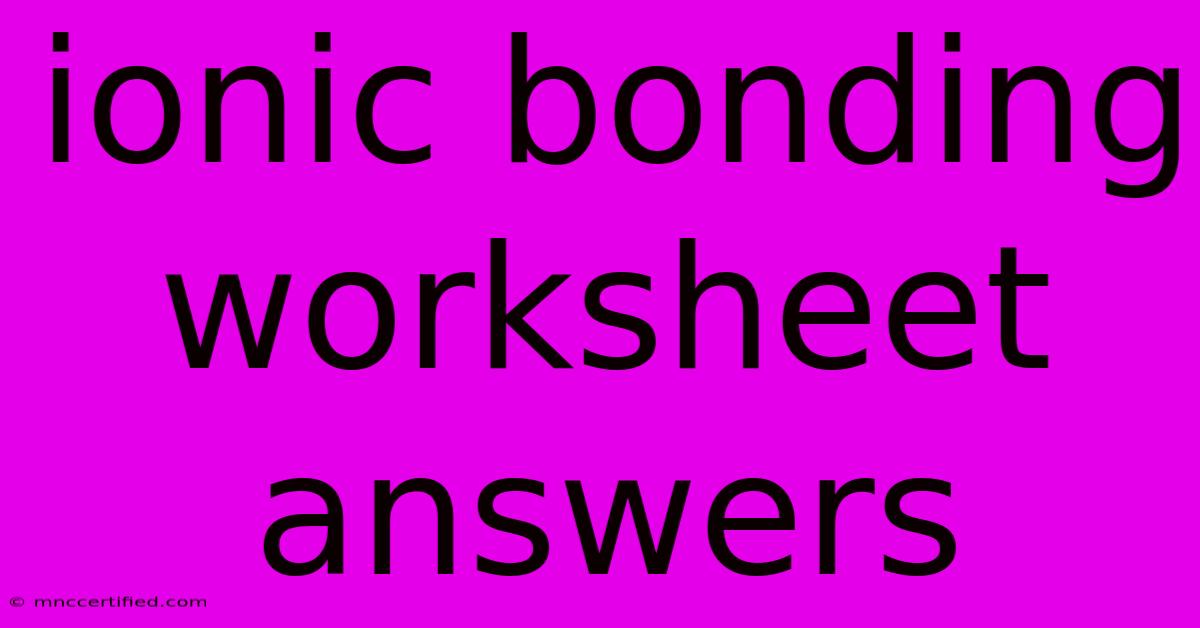Ionic Bonding Worksheet Answers

Table of Contents
Ionic Bonding Worksheet Answers: A Comprehensive Guide
Finding reliable answers to ionic bonding worksheets can be tricky. This comprehensive guide not only provides explanations to common ionic bonding questions but also helps you understand the fundamental concepts behind them. Mastering ionic bonding is crucial for success in chemistry, so let's dive in!
Understanding Ionic Bonds
Before we tackle worksheet answers, let's solidify our understanding of ionic bonds. Ionic bonds form through the electrostatic attraction between oppositely charged ions. This happens when one atom donates one or more electrons (becoming a positively charged cation) to another atom that accepts those electrons (becoming a negatively charged anion). This transfer of electrons creates a strong bond between the two ions.
Key Concepts to Remember:
- Electronegativity: The tendency of an atom to attract electrons towards itself in a chemical bond. A large difference in electronegativity between atoms is essential for ionic bond formation.
- Octet Rule: Atoms tend to gain, lose, or share electrons to achieve a stable electron configuration with eight electrons in their outermost shell (valence shell). Exceptions exist, particularly with transition metals.
- Valence Electrons: The electrons in the outermost shell of an atom, which participate in chemical bonding.
- Ions: Charged atoms formed by the gain or loss of electrons. Cations are positive, and anions are negative.
Common Ionic Bonding Worksheet Questions & Answers
Let's look at some typical questions found in ionic bonding worksheets and how to approach them:
1. Predicting Ionic Compound Formulas
Question: Predict the formula for the ionic compound formed between magnesium (Mg) and chlorine (Cl).
Answer: Magnesium is an alkaline earth metal, losing two electrons to form a Mg²⁺ cation. Chlorine is a halogen, gaining one electron to form a Cl⁻ anion. To achieve charge neutrality, two chlorine atoms are needed for each magnesium atom. Therefore, the formula is MgCl₂.
2. Naming Ionic Compounds
Question: Name the ionic compound with the formula K₂O.
Answer: K is potassium (K⁺), and O is oxygen (O²⁻). The name is Potassium Oxide. Note the lack of prefixes (like "di" or "mono") in ionic compound names.
3. Drawing Lewis Dot Structures
Question: Draw the Lewis dot structure for sodium chloride (NaCl).
Answer: Sodium (Na) has one valence electron, and chlorine (Cl) has seven. Sodium loses its valence electron to chlorine, forming Na⁺ and Cl⁻. The Lewis structure shows Na⁺ with no dots and Cl⁻ with eight dots (a full octet).
4. Identifying Ionic vs. Covalent Compounds
Question: Identify whether the following compounds are ionic or covalent: NaCl, CO₂, H₂O.
Answer: NaCl (sodium chloride) is ionic due to the large electronegativity difference between sodium and chlorine. CO₂ (carbon dioxide) and H₂O (water) are covalent, as they involve electron sharing rather than transfer.
5. Explaining Properties of Ionic Compounds
Question: Explain why ionic compounds typically have high melting and boiling points.
Answer: The strong electrostatic forces of attraction between oppositely charged ions in ionic compounds require a significant amount of energy to overcome, resulting in high melting and boiling points.
Tips for Success
- Practice, practice, practice: The best way to master ionic bonding is to work through numerous examples.
- Use resources: Consult your textbook, online tutorials, and educational videos.
- Understand the concepts: Don't just memorize; focus on grasping the underlying principles.
- Seek help when needed: Ask your teacher, classmates, or tutor for assistance if you're struggling.
By understanding the fundamentals of ionic bonding and practicing with various problems, you'll confidently tackle any ionic bonding worksheet and excel in your chemistry studies. Remember to always focus on the underlying principles, and you'll find success! Good luck!

Thank you for visiting our website wich cover about Ionic Bonding Worksheet Answers. We hope the information provided has been useful to you. Feel free to contact us if you have any questions or need further assistance. See you next time and dont miss to bookmark.
Featured Posts
-
Gatwick Airport Evacuation Security Incident
Nov 22, 2024
-
Russia Deploys Icbm In Ukraine Conflict
Nov 22, 2024
-
Seventh Iceland Volcanic Eruption
Nov 22, 2024
-
Penfed Heloc Investment Property
Nov 22, 2024
-
Auto Insurance Bonita Springs Fl
Nov 22, 2024